Financial Decision Making Report: Tesco PLC Analysis, [Semester]
VerifiedAdded on 2021/02/20
|17
|4151
|29
Report
AI Summary
This report provides a comprehensive financial analysis of Tesco PLC, a major UK retailer. It begins with an overview of the company, including its mission, values, and financial situation. The core of the report focuses on ratio analysis, examining liquidity (current and quick ratios), profitability (net profit margin, operating profit), efficiency (asset turnover), and solvency ratios. The analysis spans the years 2016-2018, providing insights into Tesco's financial performance and decision-making. The report highlights trends, identifies areas of strength and weakness, and offers a clear picture of the company's financial health. The conclusion summarizes the findings and provides an overall assessment of Tesco's financial position. The report is a valuable resource for understanding financial statements and ratio analysis applied to a real-world company.

Financial Decision
Making
Making
Paraphrase This Document
Need a fresh take? Get an instant paraphrase of this document with our AI Paraphraser
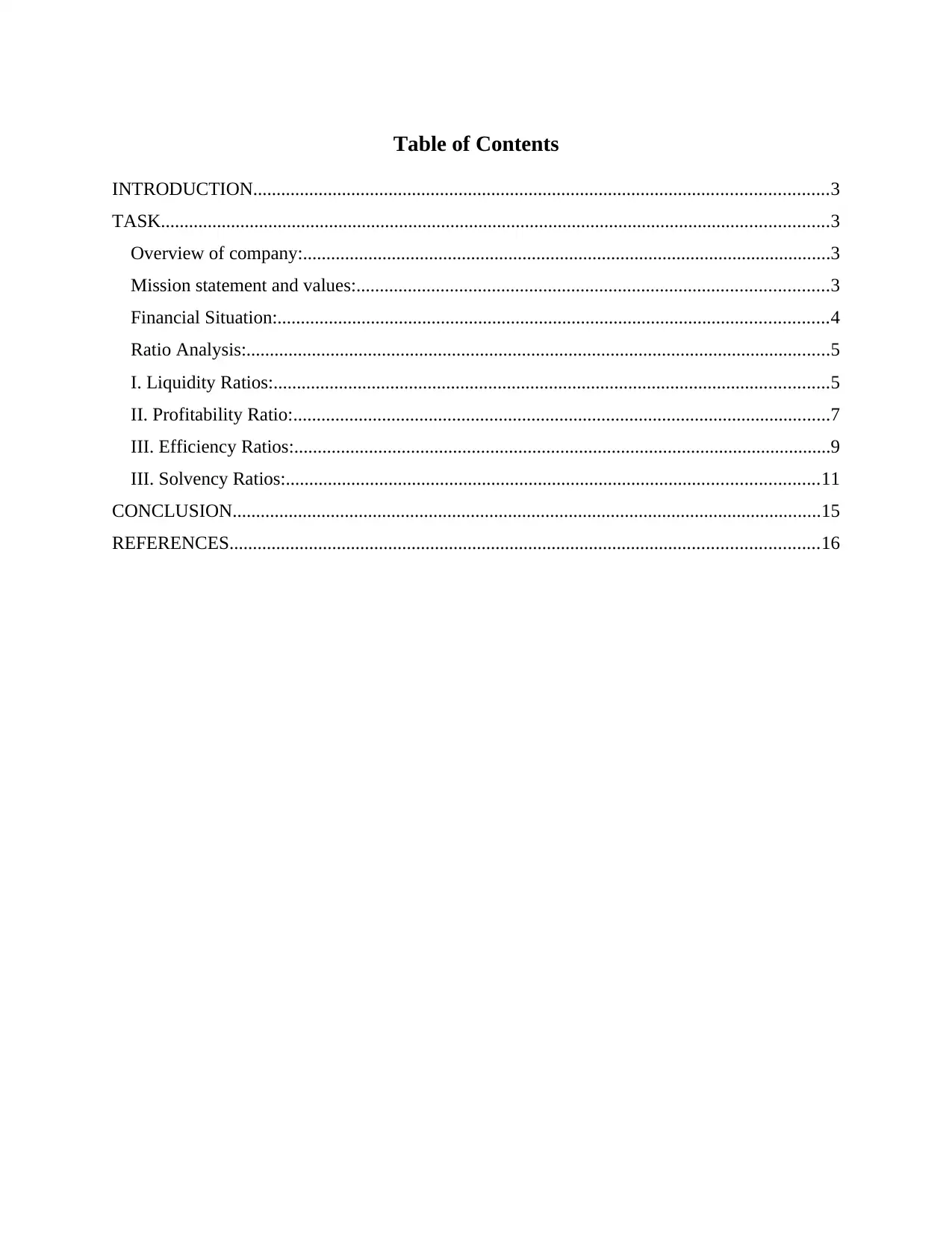
Table of Contents
INTRODUCTION...........................................................................................................................3
TASK...............................................................................................................................................3
Overview of company:.................................................................................................................3
Mission statement and values:.....................................................................................................3
Financial Situation:......................................................................................................................4
Ratio Analysis:.............................................................................................................................5
I. Liquidity Ratios:.......................................................................................................................5
II. Profitability Ratio:...................................................................................................................7
III. Efficiency Ratios:...................................................................................................................9
III. Solvency Ratios:..................................................................................................................11
CONCLUSION..............................................................................................................................15
REFERENCES..............................................................................................................................16
INTRODUCTION...........................................................................................................................3
TASK...............................................................................................................................................3
Overview of company:.................................................................................................................3
Mission statement and values:.....................................................................................................3
Financial Situation:......................................................................................................................4
Ratio Analysis:.............................................................................................................................5
I. Liquidity Ratios:.......................................................................................................................5
II. Profitability Ratio:...................................................................................................................7
III. Efficiency Ratios:...................................................................................................................9
III. Solvency Ratios:..................................................................................................................11
CONCLUSION..............................................................................................................................15
REFERENCES..............................................................................................................................16
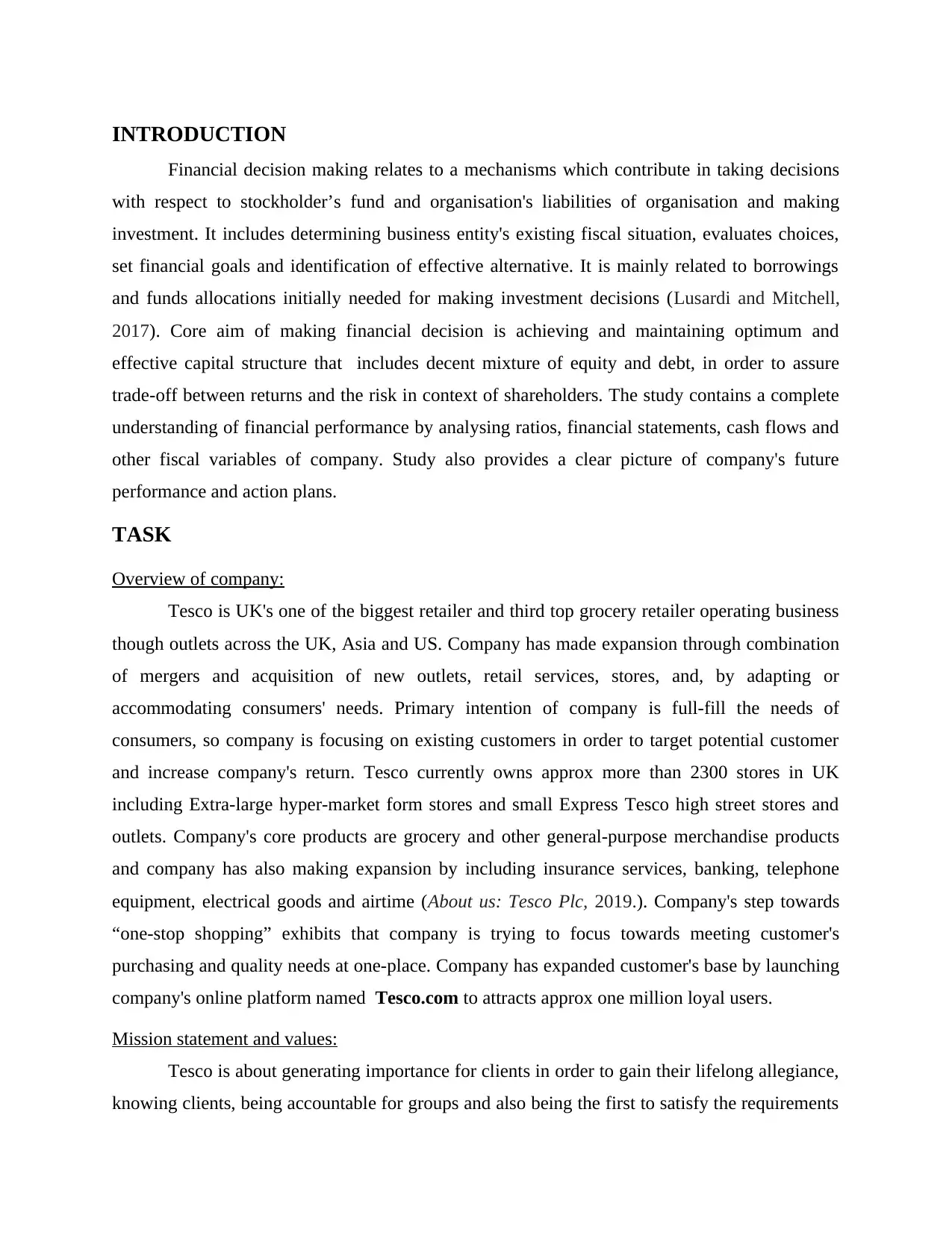
INTRODUCTION
Financial decision making relates to a mechanisms which contribute in taking decisions
with respect to stockholder’s fund and organisation's liabilities of organisation and making
investment. It includes determining business entity's existing fiscal situation, evaluates choices,
set financial goals and identification of effective alternative. It is mainly related to borrowings
and funds allocations initially needed for making investment decisions (Lusardi and Mitchell,
2017). Core aim of making financial decision is achieving and maintaining optimum and
effective capital structure that includes decent mixture of equity and debt, in order to assure
trade-off between returns and the risk in context of shareholders. The study contains a complete
understanding of financial performance by analysing ratios, financial statements, cash flows and
other fiscal variables of company. Study also provides a clear picture of company's future
performance and action plans.
TASK
Overview of company:
Tesco is UK's one of the biggest retailer and third top grocery retailer operating business
though outlets across the UK, Asia and US. Company has made expansion through combination
of mergers and acquisition of new outlets, retail services, stores, and, by adapting or
accommodating consumers' needs. Primary intention of company is full-fill the needs of
consumers, so company is focusing on existing customers in order to target potential customer
and increase company's return. Tesco currently owns approx more than 2300 stores in UK
including Extra-large hyper-market form stores and small Express Tesco high street stores and
outlets. Company's core products are grocery and other general-purpose merchandise products
and company has also making expansion by including insurance services, banking, telephone
equipment, electrical goods and airtime (About us: Tesco Plc, 2019.). Company's step towards
“one-stop shopping” exhibits that company is trying to focus towards meeting customer's
purchasing and quality needs at one-place. Company has expanded customer's base by launching
company's online platform named Tesco.com to attracts approx one million loyal users.
Mission statement and values:
Tesco is about generating importance for clients in order to gain their lifelong allegiance,
knowing clients, being accountable for groups and also being the first to satisfy the requirements
Financial decision making relates to a mechanisms which contribute in taking decisions
with respect to stockholder’s fund and organisation's liabilities of organisation and making
investment. It includes determining business entity's existing fiscal situation, evaluates choices,
set financial goals and identification of effective alternative. It is mainly related to borrowings
and funds allocations initially needed for making investment decisions (Lusardi and Mitchell,
2017). Core aim of making financial decision is achieving and maintaining optimum and
effective capital structure that includes decent mixture of equity and debt, in order to assure
trade-off between returns and the risk in context of shareholders. The study contains a complete
understanding of financial performance by analysing ratios, financial statements, cash flows and
other fiscal variables of company. Study also provides a clear picture of company's future
performance and action plans.
TASK
Overview of company:
Tesco is UK's one of the biggest retailer and third top grocery retailer operating business
though outlets across the UK, Asia and US. Company has made expansion through combination
of mergers and acquisition of new outlets, retail services, stores, and, by adapting or
accommodating consumers' needs. Primary intention of company is full-fill the needs of
consumers, so company is focusing on existing customers in order to target potential customer
and increase company's return. Tesco currently owns approx more than 2300 stores in UK
including Extra-large hyper-market form stores and small Express Tesco high street stores and
outlets. Company's core products are grocery and other general-purpose merchandise products
and company has also making expansion by including insurance services, banking, telephone
equipment, electrical goods and airtime (About us: Tesco Plc, 2019.). Company's step towards
“one-stop shopping” exhibits that company is trying to focus towards meeting customer's
purchasing and quality needs at one-place. Company has expanded customer's base by launching
company's online platform named Tesco.com to attracts approx one million loyal users.
Mission statement and values:
Tesco is about generating importance for clients in order to gain their lifelong allegiance,
knowing clients, being accountable for groups and also being the first to satisfy the requirements
⊘ This is a preview!⊘
Do you want full access?
Subscribe today to unlock all pages.

Trusted by 1+ million students worldwide
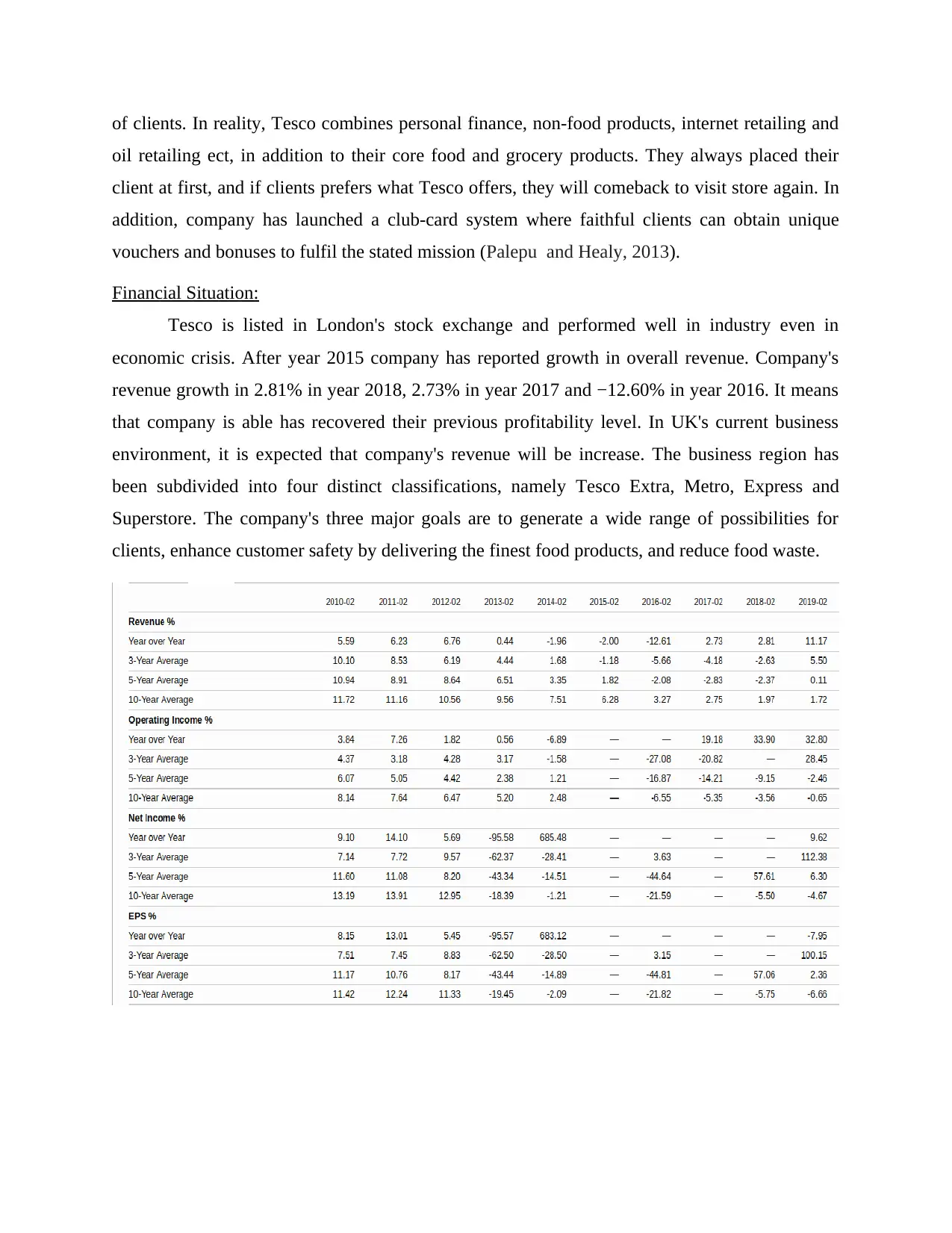
of clients. In reality, Tesco combines personal finance, non-food products, internet retailing and
oil retailing ect, in addition to their core food and grocery products. They always placed their
client at first, and if clients prefers what Tesco offers, they will comeback to visit store again. In
addition, company has launched a club-card system where faithful clients can obtain unique
vouchers and bonuses to fulfil the stated mission (Palepu and Healy, 2013).
Financial Situation:
Tesco is listed in London's stock exchange and performed well in industry even in
economic crisis. After year 2015 company has reported growth in overall revenue. Company's
revenue growth in 2.81% in year 2018, 2.73% in year 2017 and −12.60% in year 2016. It means
that company is able has recovered their previous profitability level. In UK's current business
environment, it is expected that company's revenue will be increase. The business region has
been subdivided into four distinct classifications, namely Tesco Extra, Metro, Express and
Superstore. The company's three major goals are to generate a wide range of possibilities for
clients, enhance customer safety by delivering the finest food products, and reduce food waste.
oil retailing ect, in addition to their core food and grocery products. They always placed their
client at first, and if clients prefers what Tesco offers, they will comeback to visit store again. In
addition, company has launched a club-card system where faithful clients can obtain unique
vouchers and bonuses to fulfil the stated mission (Palepu and Healy, 2013).
Financial Situation:
Tesco is listed in London's stock exchange and performed well in industry even in
economic crisis. After year 2015 company has reported growth in overall revenue. Company's
revenue growth in 2.81% in year 2018, 2.73% in year 2017 and −12.60% in year 2016. It means
that company is able has recovered their previous profitability level. In UK's current business
environment, it is expected that company's revenue will be increase. The business region has
been subdivided into four distinct classifications, namely Tesco Extra, Metro, Express and
Superstore. The company's three major goals are to generate a wide range of possibilities for
clients, enhance customer safety by delivering the finest food products, and reduce food waste.
Paraphrase This Document
Need a fresh take? Get an instant paraphrase of this document with our AI Paraphraser
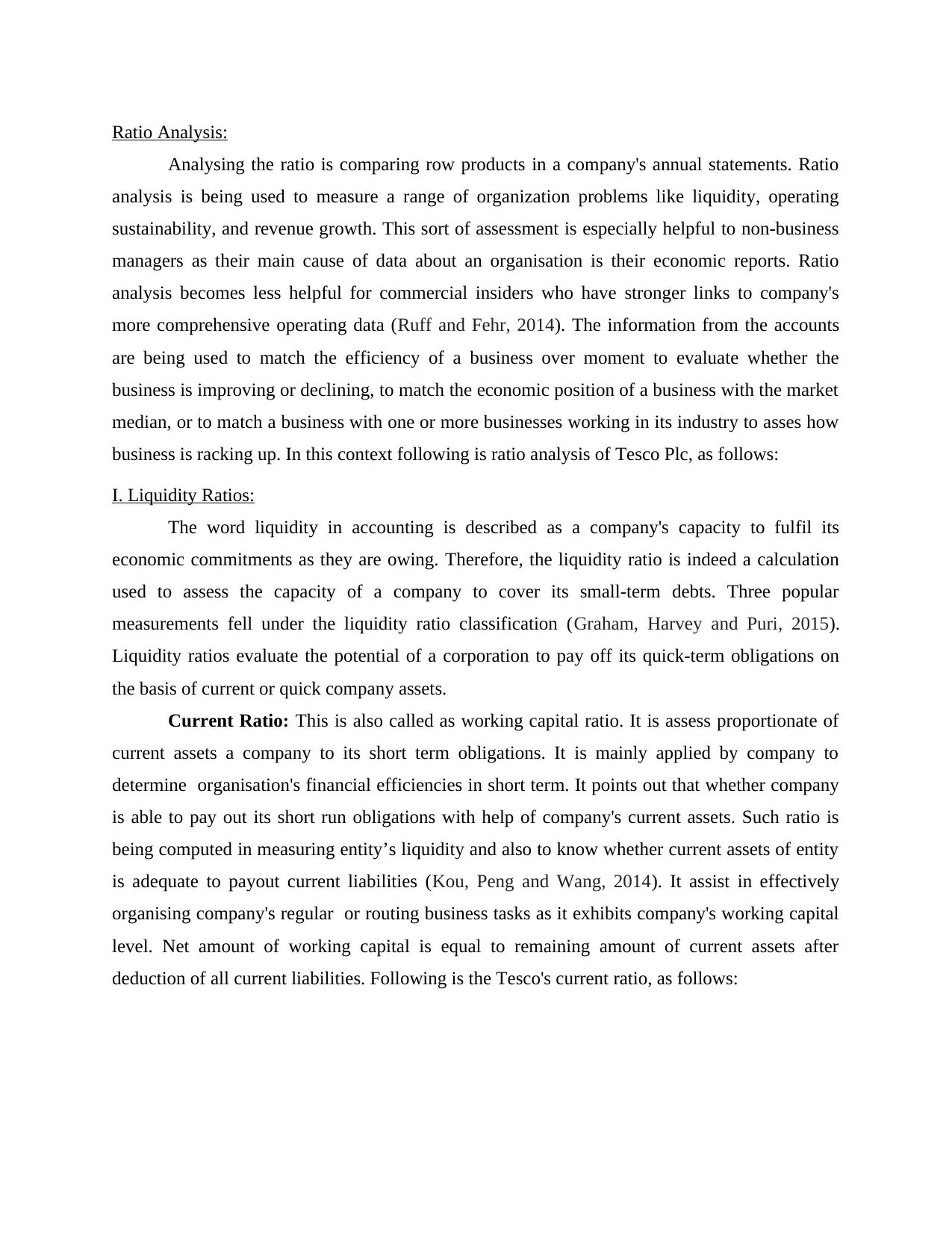
Ratio Analysis:
Analysing the ratio is comparing row products in a company's annual statements. Ratio
analysis is being used to measure a range of organization problems like liquidity, operating
sustainability, and revenue growth. This sort of assessment is especially helpful to non-business
managers as their main cause of data about an organisation is their economic reports. Ratio
analysis becomes less helpful for commercial insiders who have stronger links to company's
more comprehensive operating data (Ruff and Fehr, 2014). The information from the accounts
are being used to match the efficiency of a business over moment to evaluate whether the
business is improving or declining, to match the economic position of a business with the market
median, or to match a business with one or more businesses working in its industry to asses how
business is racking up. In this context following is ratio analysis of Tesco Plc, as follows:
I. Liquidity Ratios:
The word liquidity in accounting is described as a company's capacity to fulfil its
economic commitments as they are owing. Therefore, the liquidity ratio is indeed a calculation
used to assess the capacity of a company to cover its small-term debts. Three popular
measurements fell under the liquidity ratio classification (Graham, Harvey and Puri, 2015).
Liquidity ratios evaluate the potential of a corporation to pay off its quick-term obligations on
the basis of current or quick company assets.
Current Ratio: This is also called as working capital ratio. It is assess proportionate of
current assets a company to its short term obligations. It is mainly applied by company to
determine organisation's financial efficiencies in short term. It points out that whether company
is able to pay out its short run obligations with help of company's current assets. Such ratio is
being computed in measuring entity’s liquidity and also to know whether current assets of entity
is adequate to payout current liabilities (Kou, Peng and Wang, 2014). It assist in effectively
organising company's regular or routing business tasks as it exhibits company's working capital
level. Net amount of working capital is equal to remaining amount of current assets after
deduction of all current liabilities. Following is the Tesco's current ratio, as follows:
Analysing the ratio is comparing row products in a company's annual statements. Ratio
analysis is being used to measure a range of organization problems like liquidity, operating
sustainability, and revenue growth. This sort of assessment is especially helpful to non-business
managers as their main cause of data about an organisation is their economic reports. Ratio
analysis becomes less helpful for commercial insiders who have stronger links to company's
more comprehensive operating data (Ruff and Fehr, 2014). The information from the accounts
are being used to match the efficiency of a business over moment to evaluate whether the
business is improving or declining, to match the economic position of a business with the market
median, or to match a business with one or more businesses working in its industry to asses how
business is racking up. In this context following is ratio analysis of Tesco Plc, as follows:
I. Liquidity Ratios:
The word liquidity in accounting is described as a company's capacity to fulfil its
economic commitments as they are owing. Therefore, the liquidity ratio is indeed a calculation
used to assess the capacity of a company to cover its small-term debts. Three popular
measurements fell under the liquidity ratio classification (Graham, Harvey and Puri, 2015).
Liquidity ratios evaluate the potential of a corporation to pay off its quick-term obligations on
the basis of current or quick company assets.
Current Ratio: This is also called as working capital ratio. It is assess proportionate of
current assets a company to its short term obligations. It is mainly applied by company to
determine organisation's financial efficiencies in short term. It points out that whether company
is able to pay out its short run obligations with help of company's current assets. Such ratio is
being computed in measuring entity’s liquidity and also to know whether current assets of entity
is adequate to payout current liabilities (Kou, Peng and Wang, 2014). It assist in effectively
organising company's regular or routing business tasks as it exhibits company's working capital
level. Net amount of working capital is equal to remaining amount of current assets after
deduction of all current liabilities. Following is the Tesco's current ratio, as follows:
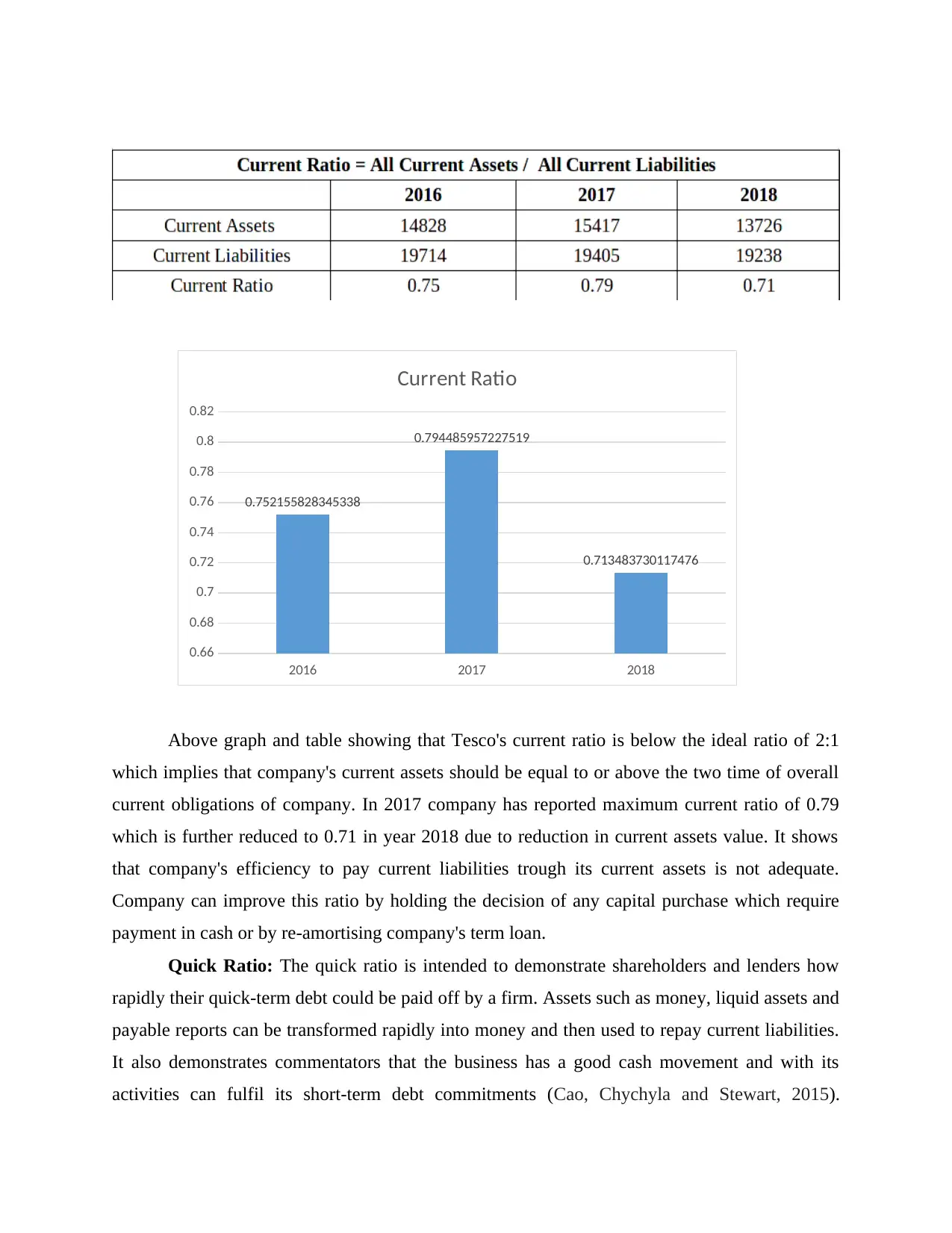
Above graph and table showing that Tesco's current ratio is below the ideal ratio of 2:1
which implies that company's current assets should be equal to or above the two time of overall
current obligations of company. In 2017 company has reported maximum current ratio of 0.79
which is further reduced to 0.71 in year 2018 due to reduction in current assets value. It shows
that company's efficiency to pay current liabilities trough its current assets is not adequate.
Company can improve this ratio by holding the decision of any capital purchase which require
payment in cash or by re-amortising company's term loan.
Quick Ratio: The quick ratio is intended to demonstrate shareholders and lenders how
rapidly their quick-term debt could be paid off by a firm. Assets such as money, liquid assets and
payable reports can be transformed rapidly into money and then used to repay current liabilities.
It also demonstrates commentators that the business has a good cash movement and with its
activities can fulfil its short-term debt commitments (Cao, Chychyla and Stewart, 2015).
2016 2017 2018
0.66
0.68
0.7
0.72
0.74
0.76
0.78
0.8
0.82
0.752155828345338
0.794485957227519
0.713483730117476
Current Ratio
which implies that company's current assets should be equal to or above the two time of overall
current obligations of company. In 2017 company has reported maximum current ratio of 0.79
which is further reduced to 0.71 in year 2018 due to reduction in current assets value. It shows
that company's efficiency to pay current liabilities trough its current assets is not adequate.
Company can improve this ratio by holding the decision of any capital purchase which require
payment in cash or by re-amortising company's term loan.
Quick Ratio: The quick ratio is intended to demonstrate shareholders and lenders how
rapidly their quick-term debt could be paid off by a firm. Assets such as money, liquid assets and
payable reports can be transformed rapidly into money and then used to repay current liabilities.
It also demonstrates commentators that the business has a good cash movement and with its
activities can fulfil its short-term debt commitments (Cao, Chychyla and Stewart, 2015).
2016 2017 2018
0.66
0.68
0.7
0.72
0.74
0.76
0.78
0.8
0.82
0.752155828345338
0.794485957227519
0.713483730117476
Current Ratio
⊘ This is a preview!⊘
Do you want full access?
Subscribe today to unlock all pages.

Trusted by 1+ million students worldwide
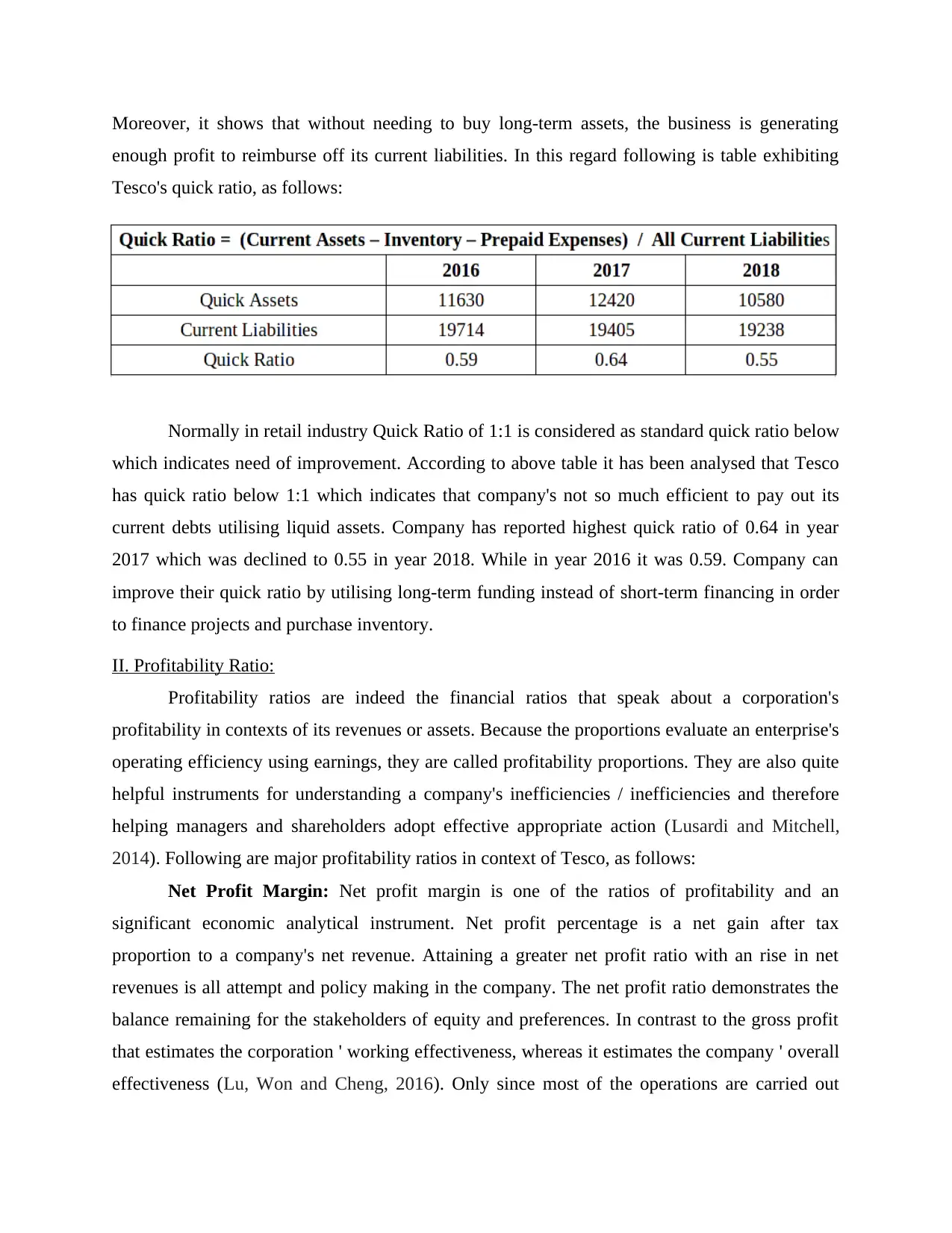
Moreover, it shows that without needing to buy long-term assets, the business is generating
enough profit to reimburse off its current liabilities. In this regard following is table exhibiting
Tesco's quick ratio, as follows:
Normally in retail industry Quick Ratio of 1:1 is considered as standard quick ratio below
which indicates need of improvement. According to above table it has been analysed that Tesco
has quick ratio below 1:1 which indicates that company's not so much efficient to pay out its
current debts utilising liquid assets. Company has reported highest quick ratio of 0.64 in year
2017 which was declined to 0.55 in year 2018. While in year 2016 it was 0.59. Company can
improve their quick ratio by utilising long-term funding instead of short-term financing in order
to finance projects and purchase inventory.
II. Profitability Ratio:
Profitability ratios are indeed the financial ratios that speak about a corporation's
profitability in contexts of its revenues or assets. Because the proportions evaluate an enterprise's
operating efficiency using earnings, they are called profitability proportions. They are also quite
helpful instruments for understanding a company's inefficiencies / inefficiencies and therefore
helping managers and shareholders adopt effective appropriate action (Lusardi and Mitchell,
2014). Following are major profitability ratios in context of Tesco, as follows:
Net Profit Margin: Net profit margin is one of the ratios of profitability and an
significant economic analytical instrument. Net profit percentage is a net gain after tax
proportion to a company's net revenue. Attaining a greater net profit ratio with an rise in net
revenues is all attempt and policy making in the company. The net profit ratio demonstrates the
balance remaining for the stakeholders of equity and preferences. In contrast to the gross profit
that estimates the corporation ' working effectiveness, whereas it estimates the company ' overall
effectiveness (Lu, Won and Cheng, 2016). Only since most of the operations are carried out
enough profit to reimburse off its current liabilities. In this regard following is table exhibiting
Tesco's quick ratio, as follows:
Normally in retail industry Quick Ratio of 1:1 is considered as standard quick ratio below
which indicates need of improvement. According to above table it has been analysed that Tesco
has quick ratio below 1:1 which indicates that company's not so much efficient to pay out its
current debts utilising liquid assets. Company has reported highest quick ratio of 0.64 in year
2017 which was declined to 0.55 in year 2018. While in year 2016 it was 0.59. Company can
improve their quick ratio by utilising long-term funding instead of short-term financing in order
to finance projects and purchase inventory.
II. Profitability Ratio:
Profitability ratios are indeed the financial ratios that speak about a corporation's
profitability in contexts of its revenues or assets. Because the proportions evaluate an enterprise's
operating efficiency using earnings, they are called profitability proportions. They are also quite
helpful instruments for understanding a company's inefficiencies / inefficiencies and therefore
helping managers and shareholders adopt effective appropriate action (Lusardi and Mitchell,
2014). Following are major profitability ratios in context of Tesco, as follows:
Net Profit Margin: Net profit margin is one of the ratios of profitability and an
significant economic analytical instrument. Net profit percentage is a net gain after tax
proportion to a company's net revenue. Attaining a greater net profit ratio with an rise in net
revenues is all attempt and policy making in the company. The net profit ratio demonstrates the
balance remaining for the stakeholders of equity and preferences. In contrast to the gross profit
that estimates the corporation ' working effectiveness, whereas it estimates the company ' overall
effectiveness (Lu, Won and Cheng, 2016). Only since most of the operations are carried out
Paraphrase This Document
Need a fresh take? Get an instant paraphrase of this document with our AI Paraphraser
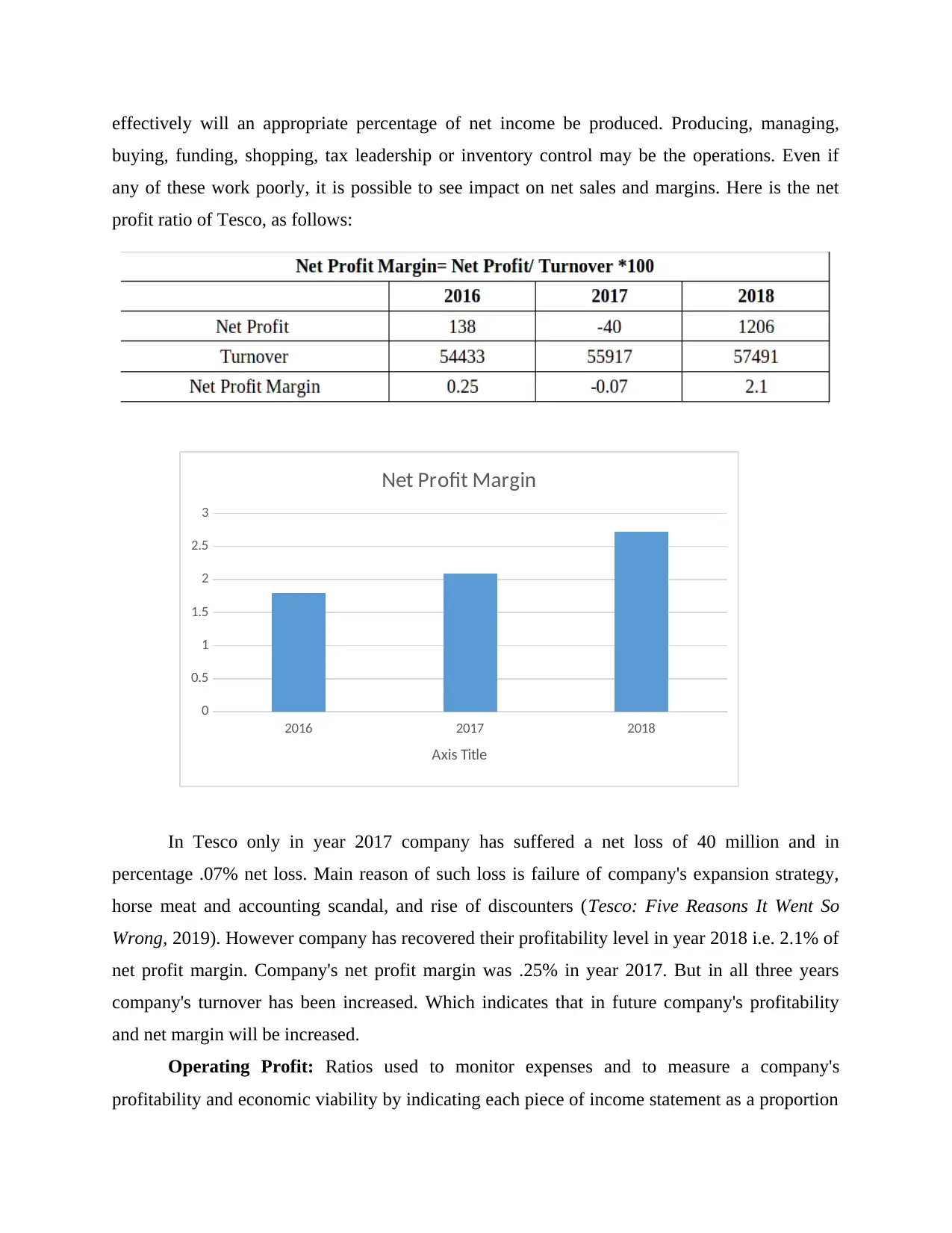
effectively will an appropriate percentage of net income be produced. Producing, managing,
buying, funding, shopping, tax leadership or inventory control may be the operations. Even if
any of these work poorly, it is possible to see impact on net sales and margins. Here is the net
profit ratio of Tesco, as follows:
In Tesco only in year 2017 company has suffered a net loss of 40 million and in
percentage .07% net loss. Main reason of such loss is failure of company's expansion strategy,
horse meat and accounting scandal, and rise of discounters (Tesco: Five Reasons It Went So
Wrong, 2019). However company has recovered their profitability level in year 2018 i.e. 2.1% of
net profit margin. Company's net profit margin was .25% in year 2017. But in all three years
company's turnover has been increased. Which indicates that in future company's profitability
and net margin will be increased.
Operating Profit: Ratios used to monitor expenses and to measure a company's
profitability and economic viability by indicating each piece of income statement as a proportion
2016 2017 2018
0
0.5
1
1.5
2
2.5
3
Net Profit Margin
Axis Title
buying, funding, shopping, tax leadership or inventory control may be the operations. Even if
any of these work poorly, it is possible to see impact on net sales and margins. Here is the net
profit ratio of Tesco, as follows:
In Tesco only in year 2017 company has suffered a net loss of 40 million and in
percentage .07% net loss. Main reason of such loss is failure of company's expansion strategy,
horse meat and accounting scandal, and rise of discounters (Tesco: Five Reasons It Went So
Wrong, 2019). However company has recovered their profitability level in year 2018 i.e. 2.1% of
net profit margin. Company's net profit margin was .25% in year 2017. But in all three years
company's turnover has been increased. Which indicates that in future company's profitability
and net margin will be increased.
Operating Profit: Ratios used to monitor expenses and to measure a company's
profitability and economic viability by indicating each piece of income statement as a proportion
2016 2017 2018
0
0.5
1
1.5
2
2.5
3
Net Profit Margin
Axis Title
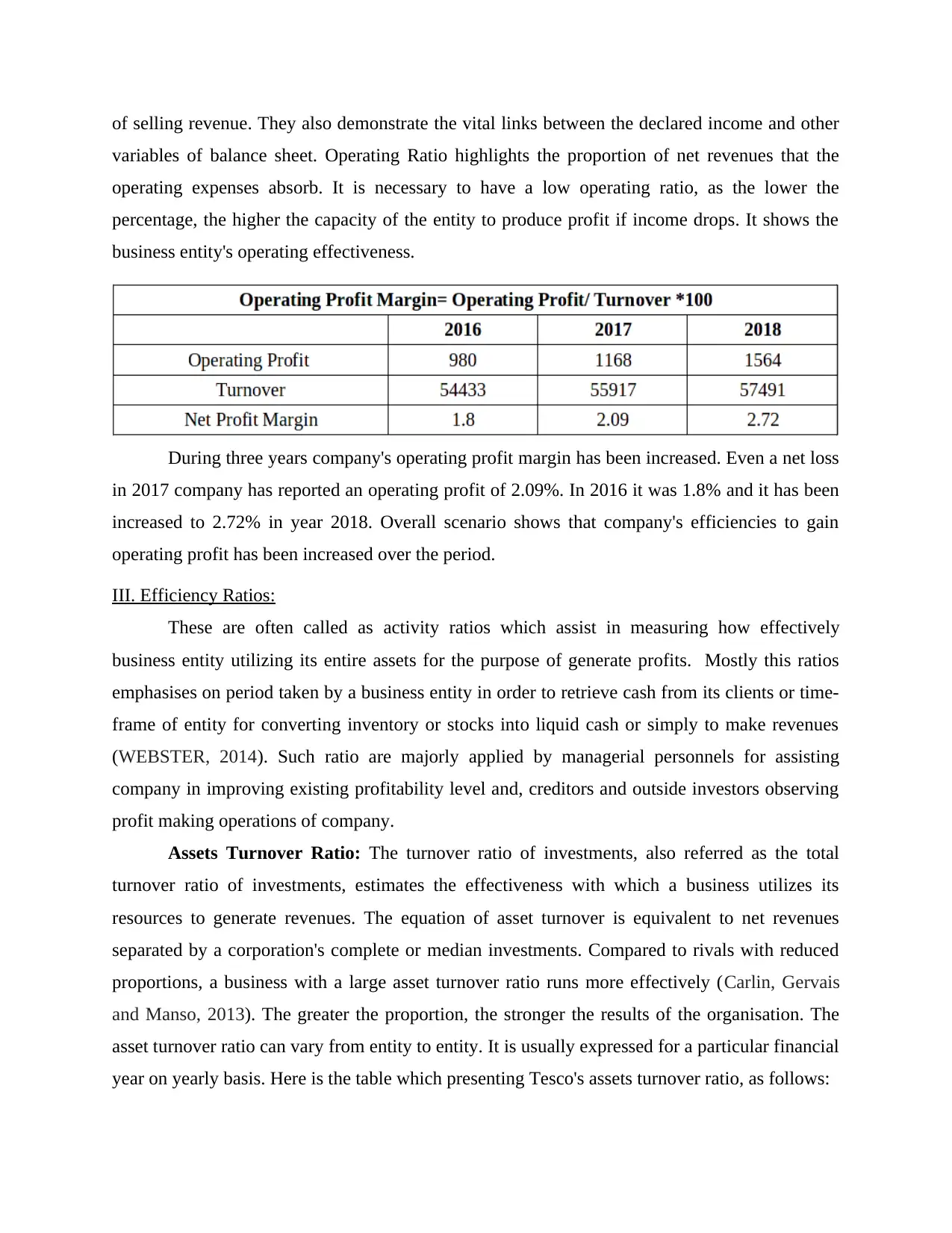
of selling revenue. They also demonstrate the vital links between the declared income and other
variables of balance sheet. Operating Ratio highlights the proportion of net revenues that the
operating expenses absorb. It is necessary to have a low operating ratio, as the lower the
percentage, the higher the capacity of the entity to produce profit if income drops. It shows the
business entity's operating effectiveness.
During three years company's operating profit margin has been increased. Even a net loss
in 2017 company has reported an operating profit of 2.09%. In 2016 it was 1.8% and it has been
increased to 2.72% in year 2018. Overall scenario shows that company's efficiencies to gain
operating profit has been increased over the period.
III. Efficiency Ratios:
These are often called as activity ratios which assist in measuring how effectively
business entity utilizing its entire assets for the purpose of generate profits. Mostly this ratios
emphasises on period taken by a business entity in order to retrieve cash from its clients or time-
frame of entity for converting inventory or stocks into liquid cash or simply to make revenues
(WEBSTER, 2014). Such ratio are majorly applied by managerial personnels for assisting
company in improving existing profitability level and, creditors and outside investors observing
profit making operations of company.
Assets Turnover Ratio: The turnover ratio of investments, also referred as the total
turnover ratio of investments, estimates the effectiveness with which a business utilizes its
resources to generate revenues. The equation of asset turnover is equivalent to net revenues
separated by a corporation's complete or median investments. Compared to rivals with reduced
proportions, a business with a large asset turnover ratio runs more effectively (Carlin, Gervais
and Manso, 2013). The greater the proportion, the stronger the results of the organisation. The
asset turnover ratio can vary from entity to entity. It is usually expressed for a particular financial
year on yearly basis. Here is the table which presenting Tesco's assets turnover ratio, as follows:
variables of balance sheet. Operating Ratio highlights the proportion of net revenues that the
operating expenses absorb. It is necessary to have a low operating ratio, as the lower the
percentage, the higher the capacity of the entity to produce profit if income drops. It shows the
business entity's operating effectiveness.
During three years company's operating profit margin has been increased. Even a net loss
in 2017 company has reported an operating profit of 2.09%. In 2016 it was 1.8% and it has been
increased to 2.72% in year 2018. Overall scenario shows that company's efficiencies to gain
operating profit has been increased over the period.
III. Efficiency Ratios:
These are often called as activity ratios which assist in measuring how effectively
business entity utilizing its entire assets for the purpose of generate profits. Mostly this ratios
emphasises on period taken by a business entity in order to retrieve cash from its clients or time-
frame of entity for converting inventory or stocks into liquid cash or simply to make revenues
(WEBSTER, 2014). Such ratio are majorly applied by managerial personnels for assisting
company in improving existing profitability level and, creditors and outside investors observing
profit making operations of company.
Assets Turnover Ratio: The turnover ratio of investments, also referred as the total
turnover ratio of investments, estimates the effectiveness with which a business utilizes its
resources to generate revenues. The equation of asset turnover is equivalent to net revenues
separated by a corporation's complete or median investments. Compared to rivals with reduced
proportions, a business with a large asset turnover ratio runs more effectively (Carlin, Gervais
and Manso, 2013). The greater the proportion, the stronger the results of the organisation. The
asset turnover ratio can vary from entity to entity. It is usually expressed for a particular financial
year on yearly basis. Here is the table which presenting Tesco's assets turnover ratio, as follows:
⊘ This is a preview!⊘
Do you want full access?
Subscribe today to unlock all pages.

Trusted by 1+ million students worldwide
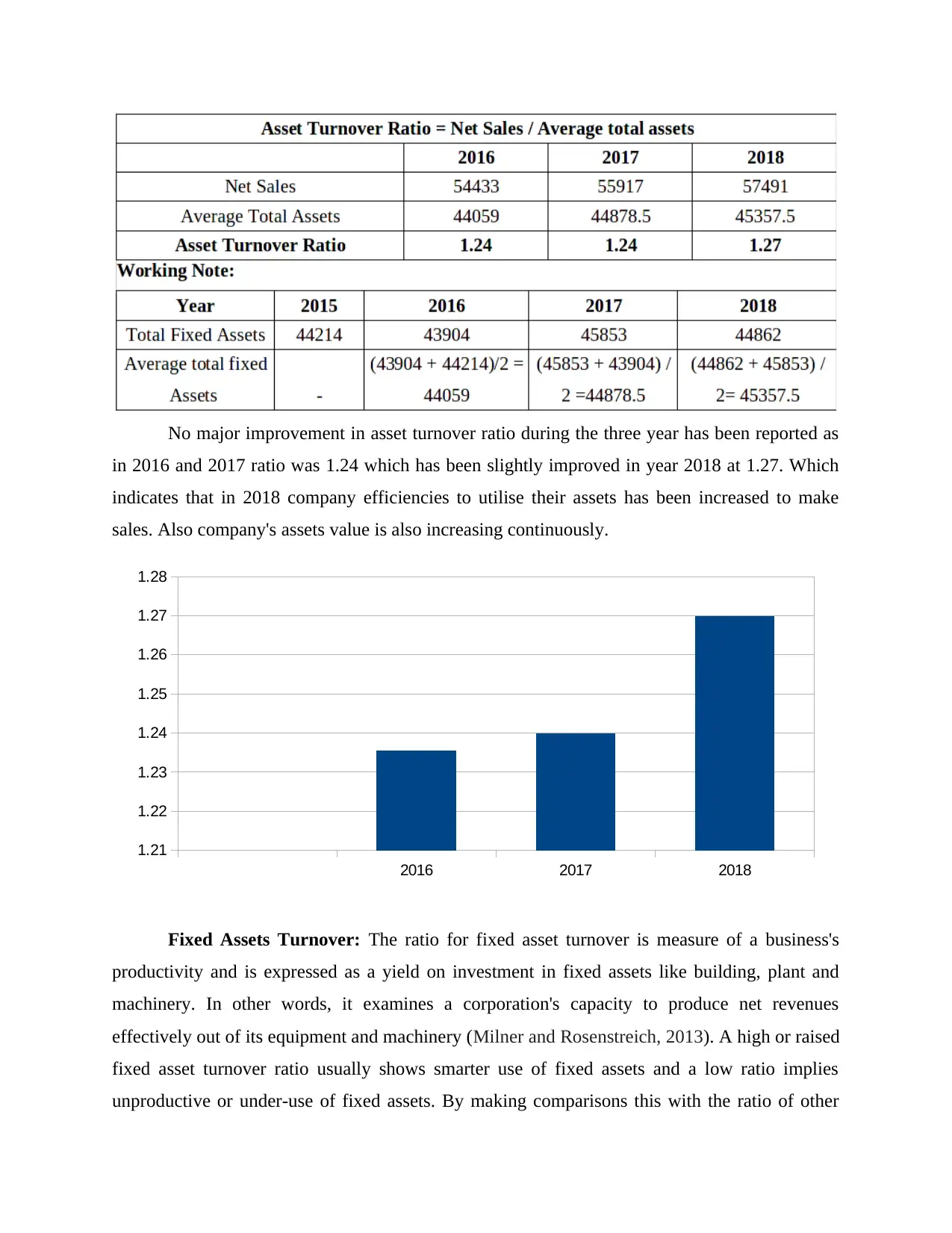
No major improvement in asset turnover ratio during the three year has been reported as
in 2016 and 2017 ratio was 1.24 which has been slightly improved in year 2018 at 1.27. Which
indicates that in 2018 company efficiencies to utilise their assets has been increased to make
sales. Also company's assets value is also increasing continuously.
Fixed Assets Turnover: The ratio for fixed asset turnover is measure of a business's
productivity and is expressed as a yield on investment in fixed assets like building, plant and
machinery. In other words, it examines a corporation's capacity to produce net revenues
effectively out of its equipment and machinery (Milner and Rosenstreich, 2013). A high or raised
fixed asset turnover ratio usually shows smarter use of fixed assets and a low ratio implies
unproductive or under-use of fixed assets. By making comparisons this with the ratio of other
2016 2017 2018
1.21
1.22
1.23
1.24
1.25
1.26
1.27
1.28
in 2016 and 2017 ratio was 1.24 which has been slightly improved in year 2018 at 1.27. Which
indicates that in 2018 company efficiencies to utilise their assets has been increased to make
sales. Also company's assets value is also increasing continuously.
Fixed Assets Turnover: The ratio for fixed asset turnover is measure of a business's
productivity and is expressed as a yield on investment in fixed assets like building, plant and
machinery. In other words, it examines a corporation's capacity to produce net revenues
effectively out of its equipment and machinery (Milner and Rosenstreich, 2013). A high or raised
fixed asset turnover ratio usually shows smarter use of fixed assets and a low ratio implies
unproductive or under-use of fixed assets. By making comparisons this with the ratio of other
2016 2017 2018
1.21
1.22
1.23
1.24
1.25
1.26
1.27
1.28
Paraphrase This Document
Need a fresh take? Get an instant paraphrase of this document with our AI Paraphraser
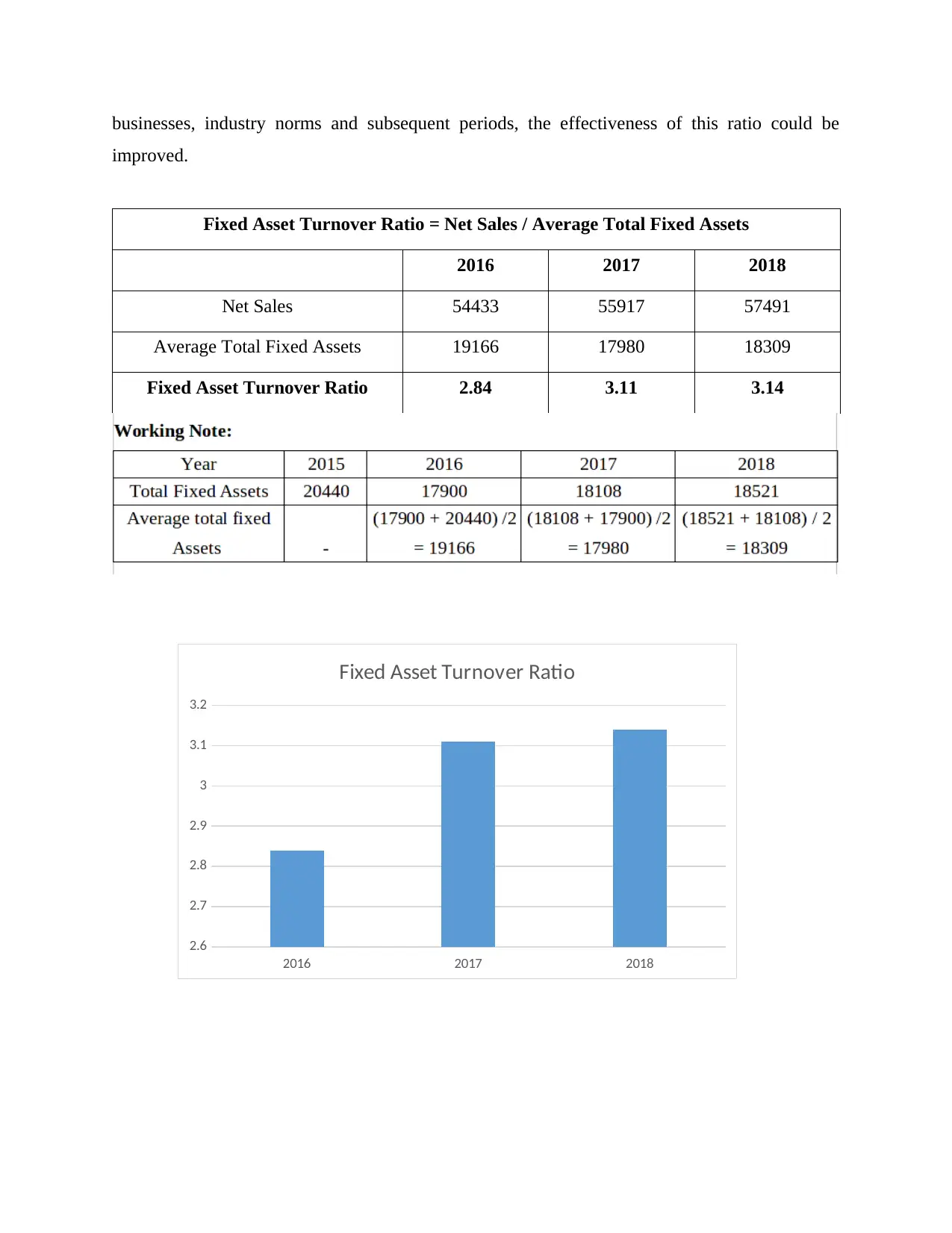
businesses, industry norms and subsequent periods, the effectiveness of this ratio could be
improved.
Fixed Asset Turnover Ratio = Net Sales / Average Total Fixed Assets
2016 2017 2018
Net Sales 54433 55917 57491
Average Total Fixed Assets 19166 17980 18309
Fixed Asset Turnover Ratio 2.84 3.11 3.14
2016 2017 2018
2.6
2.7
2.8
2.9
3
3.1
3.2
Fixed Asset Turnover Ratio
improved.
Fixed Asset Turnover Ratio = Net Sales / Average Total Fixed Assets
2016 2017 2018
Net Sales 54433 55917 57491
Average Total Fixed Assets 19166 17980 18309
Fixed Asset Turnover Ratio 2.84 3.11 3.14
2016 2017 2018
2.6
2.7
2.8
2.9
3
3.1
3.2
Fixed Asset Turnover Ratio
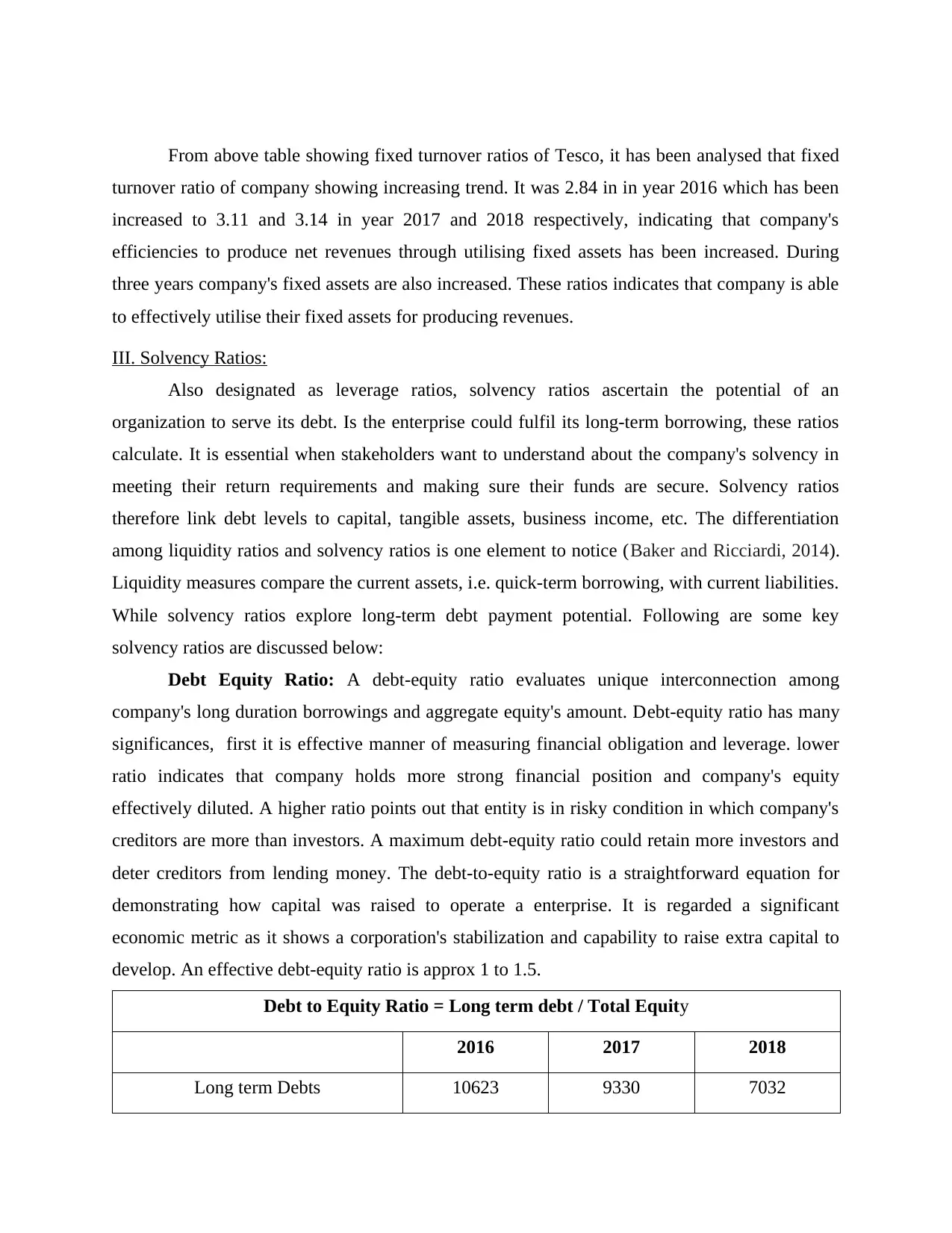
From above table showing fixed turnover ratios of Tesco, it has been analysed that fixed
turnover ratio of company showing increasing trend. It was 2.84 in in year 2016 which has been
increased to 3.11 and 3.14 in year 2017 and 2018 respectively, indicating that company's
efficiencies to produce net revenues through utilising fixed assets has been increased. During
three years company's fixed assets are also increased. These ratios indicates that company is able
to effectively utilise their fixed assets for producing revenues.
III. Solvency Ratios:
Also designated as leverage ratios, solvency ratios ascertain the potential of an
organization to serve its debt. Is the enterprise could fulfil its long-term borrowing, these ratios
calculate. It is essential when stakeholders want to understand about the company's solvency in
meeting their return requirements and making sure their funds are secure. Solvency ratios
therefore link debt levels to capital, tangible assets, business income, etc. The differentiation
among liquidity ratios and solvency ratios is one element to notice (Baker and Ricciardi, 2014).
Liquidity measures compare the current assets, i.e. quick-term borrowing, with current liabilities.
While solvency ratios explore long-term debt payment potential. Following are some key
solvency ratios are discussed below:
Debt Equity Ratio: A debt-equity ratio evaluates unique interconnection among
company's long duration borrowings and aggregate equity's amount. Debt-equity ratio has many
significances, first it is effective manner of measuring financial obligation and leverage. lower
ratio indicates that company holds more strong financial position and company's equity
effectively diluted. A higher ratio points out that entity is in risky condition in which company's
creditors are more than investors. A maximum debt-equity ratio could retain more investors and
deter creditors from lending money. The debt-to-equity ratio is a straightforward equation for
demonstrating how capital was raised to operate a enterprise. It is regarded a significant
economic metric as it shows a corporation's stabilization and capability to raise extra capital to
develop. An effective debt-equity ratio is approx 1 to 1.5.
Debt to Equity Ratio = Long term debt / Total Equity
2016 2017 2018
Long term Debts 10623 9330 7032
turnover ratio of company showing increasing trend. It was 2.84 in in year 2016 which has been
increased to 3.11 and 3.14 in year 2017 and 2018 respectively, indicating that company's
efficiencies to produce net revenues through utilising fixed assets has been increased. During
three years company's fixed assets are also increased. These ratios indicates that company is able
to effectively utilise their fixed assets for producing revenues.
III. Solvency Ratios:
Also designated as leverage ratios, solvency ratios ascertain the potential of an
organization to serve its debt. Is the enterprise could fulfil its long-term borrowing, these ratios
calculate. It is essential when stakeholders want to understand about the company's solvency in
meeting their return requirements and making sure their funds are secure. Solvency ratios
therefore link debt levels to capital, tangible assets, business income, etc. The differentiation
among liquidity ratios and solvency ratios is one element to notice (Baker and Ricciardi, 2014).
Liquidity measures compare the current assets, i.e. quick-term borrowing, with current liabilities.
While solvency ratios explore long-term debt payment potential. Following are some key
solvency ratios are discussed below:
Debt Equity Ratio: A debt-equity ratio evaluates unique interconnection among
company's long duration borrowings and aggregate equity's amount. Debt-equity ratio has many
significances, first it is effective manner of measuring financial obligation and leverage. lower
ratio indicates that company holds more strong financial position and company's equity
effectively diluted. A higher ratio points out that entity is in risky condition in which company's
creditors are more than investors. A maximum debt-equity ratio could retain more investors and
deter creditors from lending money. The debt-to-equity ratio is a straightforward equation for
demonstrating how capital was raised to operate a enterprise. It is regarded a significant
economic metric as it shows a corporation's stabilization and capability to raise extra capital to
develop. An effective debt-equity ratio is approx 1 to 1.5.
Debt to Equity Ratio = Long term debt / Total Equity
2016 2017 2018
Long term Debts 10623 9330 7032
⊘ This is a preview!⊘
Do you want full access?
Subscribe today to unlock all pages.

Trusted by 1+ million students worldwide
1 out of 17